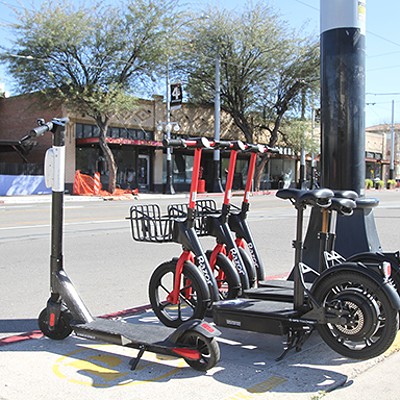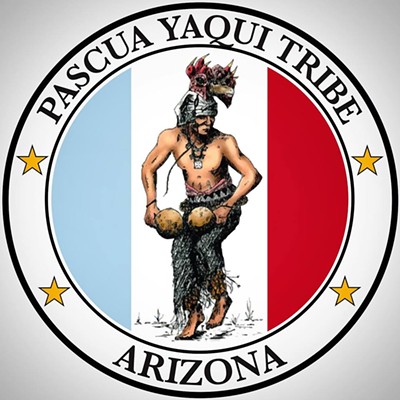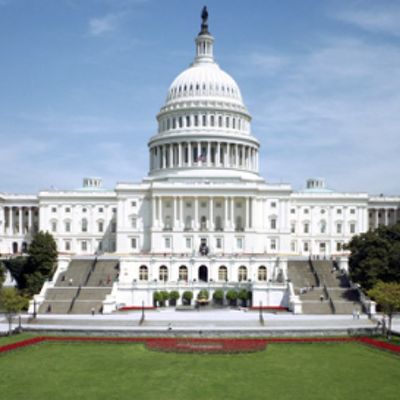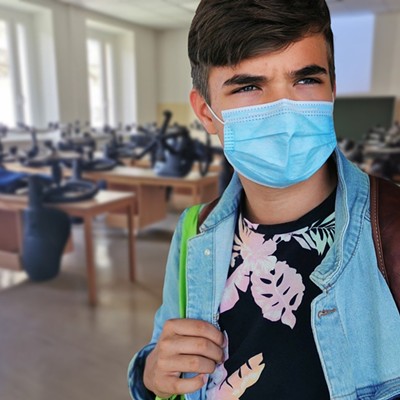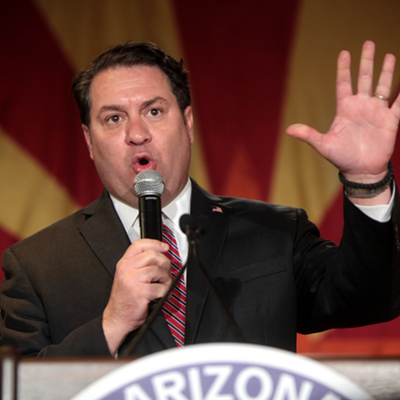NEWT RISES IN THE WEST
Republican Newt Gingrich is now leading the GOP presidential pack in Arizona.
Gingrich had the support of 28 percent of GOP voters, compared to 23 percent for Mitt Romney; 17 percent for Herman Cain; 8 percent for Ron Paul; 5 percent for Jon Huntsman; 3 percent each for Michele Bachmann, Rick Perry and Rick Santorum; and zero percent—yes, zero percent—for Gary Johnson, according to a survey of 400 Republican-primary voters released earlier this week by Public Policy Polling.
Tom Jensen, director of Public Policy Polling, notes that Gingrich is leading both among self-identified Tea Partiers—33 percent of them like him, as opposed to the 18 percent who like Romney—and among Republicans who say they aren't members of the Tea Party, where the split is closer: 26 percent for Gingrich, and 25 percent for Romney.
GOP voters appear to be getting tired of their previous saviors from the flippy-floppiness of Romney. Cain's numbers are sliding everywhere that PPP is polling, and Perry is way down at 3 percent. Oops, indeed. That's a Texas-style boom 'n' bust right there.
While Newt is flying high now, a collapse could be right around the corner. As Jensen notes in his release: "If there's one thing we've learned with this GOP contest, it's that the top is a dangerous place to be."
PPP released a second poll showing that Congressman Jeff Flake is running away with the GOP nomination to replace the retiring Sen. Jon Kyl.
Flake had the support of 53 percent of GOP voters, while just 7 percent supported Wil Cardon, who has said he's willing to spend a lot of his own money to knock out Flake.
Nearly half the voters—48 percent—had a favorable view of Flake, while 13 percent had a negative view.
Only 18 percent of GOP primary voters recognized Cardon's name—and of those who did, 11 percent had an unfavorable view, compared to the 7 percent who had a favorable impression.
TUCSON: A CITY DIVIDED
After the Tucson City Council approved the election canvass last week, we finally got a chance to look at the ward-by-ward breakdown—and the story remains the same for Tucson: We are a city divided.
If you look at the eastside wards, the Republican candidates dominated the races. In southeast-side Ward 4, Republican challenger Tyler Vogt crushed Democratic Shirley Scott by a nearly 2-to-1 margin, landing 63 percent of the vote to Scott's 37 percent.
In northeast-side Ward 2, Republican Jennifer Rawson beat Democratic Councilman Paul Cunningham by 6 percentage points, winning 53 percent to Cunningham's 47 percent.
In other words: If we had ward-only general-election voting in the city, Scott and Cunningham would have lost their races.
But because we have citywide voting, where all city voters have a say in the races, Scott won by a narrow margin—just 2 percentage points, or fewer than 1,900 votes—while Cunningham cruised to victory with a 14-percentage-point margin over Rawson.
The mayor's race went down the same way: Citywide, Democrat Jonathan Rothschild clobbered Republican Rick Grinnell by 15 percentage points, winning about 55 percent of the vote to Grinnell's 40 percent.
But in Ward 4, the numbers were almost exactly reversed: Grinnell won 55 percent of the vote to Rothschild's 41 percent. In Ward 2, Grinnell got nearly 51 percent of the vote to Rothschild's 46 percent.
Across the rest of the city, Rothschild crushed Grinnell, winning with 61 percent to 68 percent of the vote.
This is not a new story; it's the trend that has followed city elections for more than a decade now. The eastside of the city votes for Republicans who occasionally win (oddly enough, generally in heavily Democratic, city-center wards), while the rest of the city goes for the Democrats.
However, the system has resulted in moderate politicians. Cunningham and Scott are the most-moderate Democrats on the council, while the Republicans have been relatively centrist. (Remember, it was Republicans who started charging for trash collection and created impact fees on developers.)
BTW: The city's new vote-by-mail program didn't do much to change turnout in the wards that typically have low voter participation.
In westside Ward 1, just 26 percent of voters cast ballots. In southside Ward 5, just 23 percent voted.
Compare that to Ward 2, where 39 percent voted, or Ward 4, where 34 percent turned out.
The only Democratic ward to rival those numbers is midtown Ward 6, where 33 percent of the voters turned out. In northside Ward 3, that number dropped to 26 percent.
Bottom line: Even though the Democrats swept the city election, they have a long way to go to win over voters on the eastside of town—or to get their own voters to turn out.
A change may be on the way. The Arizona Supreme Court is set to hear an appeal to a court decision that voided a state law changing Tucson's election system to a nonpartisan, ward-only system.
The law, sponsored by former state lawmaker Jonathan Paton, was challenged by the city of Tucson, which argued that the manner in which it held elections was a matter of local concern.
The city lost at the trial-court level, but the Arizona Court of Appeals reversed that decision, which is why we still had citywide, partisan elections this year.
The Supreme Court is scheduled to hear an appeal of that decision on Dec. 6.
HUNGRY FOR HELP
While you're giving thanks this Thursday, you might also consider giving something to the Community Food Bank of Southern Arizona.
Demand is so high that the Food Bank can't even give away the traditional holiday box of ham and various trimmings to those in need.
Food Bank CEO Bill Carnegie tells The Skinny that while donations are on the rise, demand continues to climb with each month.
"Four years ago, we were assisting 98,000 men, women and children a month," Carnegie says. "Last month was 240,000. Each month, we're seeing a double-digit increase in the number of people seeking help. Last month was a 16 percent increase over the previous month. It's really unprecedented."
Carnegie says he's not expecting to see the demand drop before 2018, because the economic forecast is so weak. And he's worried—with the failure of the Super Committee to come up with a solution to the nation's budget problems—that big federal cuts are looming. While no one can know where Congress will make the specific cuts that are now in the pipeline, he fears that the Community Food Bank could lose as much as 30 percent of the food it now receives through the government, as well as a lot of the money that pays for administrative expenses.
"It's a perfect storm: cutting benefits and resources to basic-needs organizations at a time when need has never been greater since the Great Depression," Carnegie says.
If you're interested in giving to the Community Food Bank, you can visit the website at communityfoodbank.com, or call 622-0525 to find out how to make a donation.







